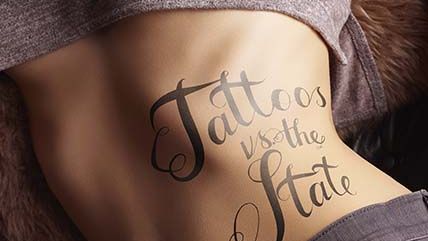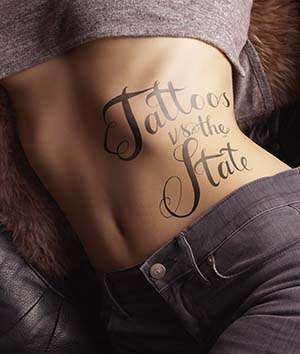Tattoos vs. the State
Free speech in skin and ink


Tattoo artists Tom and Elizabeth Preston jumped through every regulatory hoop that the city of Tempe, Arizona, placed in their way. The couple filed the necessary paperwork for opening a tattoo parlor on the north side of town, paid the necessary fees, and obtained the necessary permits before breaking proverbial ground on a studio called Body Accents. But then, after the Prestons had spent more than $30,000 on renovations, permits, and related costs, Tempe abruptly changed its tune. Their original operating permit was revoked, the Prestons were told, because the proposed tattoo shop might attract an unsavory clientele. The message was clear: Take your inky business elsewhere.
But the Prestons had a better idea. They joined forces with the lawyers at the Goldwater Institute, a free market think tank in Phoenix, and filed suit against the city for abusing its regulatory authority and violating their rights. In 2009 Maricopa County Superior Court Judge Robert H. Oberbillig ruled in their favor. The city's actions were arbitrary and capricious, Oberbillig declared, and the Prestons' original permit must be reinstated. One year later, Tempe dropped its appeal of the decision and settled the case.
"Clearly, we lost money because we couldn't open the studio three years ago," Elizabeth Preston observed at the time. But at least the pair were finally able to get on with the business of earning a living. "This lifts such a weight off of our shoulders."
Preston v. Hallman was not the first time that the skin-and-ink trade came to grips with the regulatory state, and it surely won't be the last. Over the past half-century, tattoo artists have been subjected to all manner of overreaching, ill-fitting, and just plain nonsensical government controls. They've been hassled by clueless health departments, shut down by moralizing zoning boards, and outlawed entirely by busybody city councils and state legislatures. But tattoo artists can be a prickly bunch, and increasingly they're opting to fight back. In recent years tattooists around the country have launched a series of civil liberties lawsuits designed to put the government's regulatory malfeasance on trial. And while the ink-masters aren't winning every case, their legal attacks are finally starting to turn the tide.
'A Barbaric Survival'
The art of tattooing has been around for millennia, but the modern tattoo industry effectively got its start on December 8, 1891, when a New York City tattooist named Samuel F. O'Reilly received a patent for the electric tattoo machine. Based on the design for Thomas Edison's autographic printer, which was essentially a motorized engraving tool, O'Reilly's invention sped up the process of tattooing while vastly improving the quality of the final product. Prior to his innovation, tattoos were done by hand, usually with a set of needles affixed to a wooden handle. Even for the most skilled practitioners, it was slow-going work. During the Spanish-American War of 1898, by contrast, O'Reilly reportedly inked upwards of 130 naval reservists in a single day from his small shop at 11 Chatham Square, located at the southern end of New York's famous Bowery.
O'Reilly revolutionized the business in other ways as well. As the journalist Albert Parry remarked in his 1933 book Tattoo: Secrets of a Strange Art as Practised among the Natives of the United States, the New Yorker "expanded the choice of materials till it included such old and new stuff as powdered charcoal, finely powdered brick-dust, coal-dust, lamp black, Prussian blue, washing blue, gunpowder, cinnabar, ordinary writing ink, China ink, India ink, and other vegetable inks." O'Reilly dubbed himself "Professor," and took on several apprentices over the years, including future tattoo legend Charlie Wagner, who would go on to work the Bowery until the early 1950s. Today's tattoo artists and enthusiasts remain in O'Reilly's debt.
Perhaps unsurprisingly, the same city that witnessed the birth of modern tattooing also inaugurated one of the first massive crackdowns on the practice. That effort culminated in 1961, when New York City declared it "unlawful for any person to tattoo a human being," a prohibition that remained on the books for nearly four decades. Gotham finally relegalized the tattoo trade in 1997.
New York's tattoo ban was a classic case of regulators using a bogus public-health pretext to hound an unpopular activity out of existence. Blaming tattooing—falsely—for a minor outbreak of Hepatitis B, city health officials went on the attack, declaring that "from a public health point of view" the tattoo industry was "not regulatable." Only a total ban would save the citizenry, the government claimed.
Fred Grossman, a tattooist who worked out of a shop in Coney Island, took a different view. He brought suit, charging the city with using its regulatory powers for illegitimate ends. But when his case finally reached the courtroom, Grossman hit a brick wall of judicial indifference.
According to state appellate Judge Aron Steuer, "the decoration, so-called, of the human body by tattoo designs is, in our culture, a barbaric survival, often associated with a morbid or abnormal personality." Tattooists found no refuge in Steuer's courtroom.
Grossman next appealed to the state's highest court, but it was equally dismissive. "In its wisdom, the board in the case before us decided that the prohibition of lay tattooing was essential for the protection of the public health," the court ruled in Grossman v. Baumgartner (1966). Because "the police power is exceedingly broad…the courts will not substitute their judgment of a public health problem for that of eminently qualified physicians in the field of public health."
As an authority for that deferential stance, New York's high court cited the U.S. Supreme Court's 1938 opinion in the landmark New Deal case United States v. Carolene Products Co. In that far-reaching decision, written by Justice Harlan Fiske Stone, the Supreme Court held that when it came to "regulatory legislation affecting ordinary commercial transactions…the existence of facts supporting the legislative judgment is to be presumed." In other words, in all constitutional disputes between the government and the businesses it regulates, the scales of justice must be tipped overwhelmingly in favor of the regulators. Needless to say, such sweeping judicial deference spelled doom for New York City's beleaguered tattoo artists, who were now transformed from law-abiding entrepreneurs to outlaws plying their trade in the shadows.
'Tattooing Is an Art Form'
Carolene Products effectively ended the idea of tattooists challenging regulations from their position as entrepreneurs. But that same decision also planted the seeds for a future counterattack. "More exacting judicial scrutiny," the Carolene Products Court explained in a footnote, would still be appropriate in other types of cases. For example, judges should not automatically defer to the government in cases involving "a specific prohibition of the Constitution, such as those of the first ten amendments."
The implication of that footnote did not go unnoticed. What if tattooists tried fighting government regulation from their position as artists engaged in the venerable act of free expression, as protected by the First Amendment?
In 2000, an award-winning tattoo artist named Stephen Lanphear joined forces with the American Civil Liberties Union and proceeded to pose that very question. Lanphear filed suit against the state of Massachusetts, which had declared it a crime, punishable by up to one year in prison, for any person except a doctor to mark "the body of any person by means of tattooing."
"Tattooing is an art form," Lanphear argued in his lawsuit. And "the acts of creating and wearing tattoo art are forms of expression protected by the First Amendment to the United States Constitution." State Superior Court Judge Barbara J. Rouse soon agreed. "The act of tattooing is inseparable from the display of the tattoo itself and is expression protected by the First Amendment," Rouse held in Lanphear v. Commonwealth of Massachusetts. "Any regulation of the tattooing process must, therefore, comply with constitutional requirements." The Bay State's tattoo ban was struck from the books.
Six years later, a California tattooist named Johnny Anderson took the fight to federal court, filing a First Amendment challenge against Hermosa Beach's prohibition on the operation of tattoo shops within city limits. "The tattoo designs that are applied by me are individual and unique creative works of visual art," Anderson maintained; therefore, he argued, they deserve full constitutional protection.
After losing at federal district court, Anderson went on to secure a landmark 2010 victory at federal appellate court, the highest level of the federal judiciary short of the U.S. Supreme Court. "The tattoo itself, the process of tattooing, and the business of tattooing are forms of pure expression fully protected by the First Amendment," declared a unanimous three-judge panel of the U.S. Court of Appeals for the 9th Circuit. It was the tattoo trade's greatest victory to date against the regulatory state.
'Sheltered by the First Amendment'
The 9th Circuit's decision in Anderson v. City of Hermosa Beach reverberated in courtrooms far and wide. Two years later, for example, in a decision that repeatedly cited Anderson, the Arizona Supreme Court ruled in favor of tattooists Ryan and Laetitia Coleman in their fight against the Mesa City Council, which had denied them a permit on the grounds that their proposed tattoo shop might increase crime and lower property values.
"We conclude that the approach adopted in Anderson is most consistent with First Amendment case law and the free speech protections under Arizona's Constitution," the Arizona Supreme Court ruled in Coleman v. City of Mesa. "Anderson starts with the proposition that a tattoo itself is pure speech. This seems incontrovertible." The Colemans' tattoo shop was soon open for business.
The year 2016 brought even better news for the tattoo world. On January 6 a Florida tattooist named Brad Buehrle convinced the U.S. Court of Appeals for the 11th Circuit to overrule Key West's tattoo ban, opening the way for Buehrle to open a tattoo shop in the city's historic district.
City officials had opposed Buehrle's enterprise on the grounds that his business would mar Key West's "character and fabric" and thereby "impact tourism." The city also maintained that it had a legitimate interest in preventing drunken tourists from getting marked for life.
The 11th Circuit thought otherwise. "The act of tattooing is sheltered by the First Amendment," the court observed. "The right to display a tattoo loses meaning if the government can freely restrict the right to obtain a tattoo in the first place."
The 11th Circuit was particularly unimpressed by the city's flimsy attempt to frame its ban as a proper exercise of government power. "The City conducted no investigation and made no findings," the 11th Circuit observed. "It failed to muster even anecdotal evidence supporting its claims. The closest the City came to presenting evidence on the impact on tourism was a passing reference to a few lines of a Jimmy Buffett song. And we are unsure whether even that reference fully supports its position." It was not the regulatory state's finest day in court.
Modern American tattooing has come a long way from its humble origins on the Bowery. No longer confined to the bodies of sailors or sideshow freaks, tattoos have entered the cultural mainstream, becoming a familiar sight in the worlds of fashion, pro sports, pop music, and Hollywood. And between the 9th Circuit and the 11th Circuit, seven states are now governed by judicial precedent holding the act of tattooing to be fully protected by the First Amendment. Judges in other jurisdictions can't help but take notice of that.
Tattoo artists can't expect to win every case. But the odds against them don't seem quite so long anymore.
This article originally appeared in print under the headline "Tattoos vs. the State."


Show Comments (74)